While eating their lunch, students had the opportunity to learn about the censorship of books that feature or focus on LGBTQ+ themes.
The Pride Center hosted its first Lunch and Learn event on Oct. 13, creating a space to learn about and discuss the modern censorship of queer literature.
The event invited participants to bring their own lunch and listen to a presentation while they ate and engaged in a student-staff-led discussion
Layla Izquierdo, ‘25, works at the Pride Center and hosted the event.
“A lot of people who were here were open to the discussion, which helped to facilitate a safe space for people to talk about ideas,” Izquierdo said.
She presented some of the many existing policies that allow schools and libraries to ban books that they find too controversial, such as Texas’s Classroom Censorship Law or Florida’s Parental Rights in Education policy.

The Pride Center hosted a Banned Books “Lunch and Learn” on Oct. 13 in STEPS. The event began with audience participation reflecting on what censorship means. (Yiwen Wu/B&W Staff)
Jomarck Moreno, ‘25, said it is ridiculous that different schools and libraries can ban books with no basis behind it.
“Not including an LGBT perspective by banning books promotes the idea that it’s bad to be part of the LGBTQ community,” Moreno said.
Many of these banned literary works center around the experience of queer teens and young adults, resulting in many books being inaccessible to queer youth. In 2021, the American Library Association named the novel “Gender Queer” by Maia Kobabe as the most challenged book of the year, meaning many libraries and schools across the country banned it.
The Lunch and Learn also emphasized the impact of not including LGBTQ+ perspectives in literature.
“Lack of queer representation, especially in younger grades, leads to more bigoted adults,” Izquierdo said. “If you don’t learn about diverse experiences, you start to think that they’re abnormal.”
Izquierdo said she has been passionate about this topic since she took a class on banned literature in high school where she was exposed to many different ideas regarding censorship.
“I thought that I would incorporate that idea with parts of my identity because of the personal experiences that I’ve had with harassment and homophobia and how that kind of representation was missing when I was growing up,” Izquierdo said.
The group discussion provided a space for people to open up about similar personal experiences with issues brought on by the inability to see queer representation in media.
Julia Rock-Torcivia, ‘25, said she struggled with figuring out her identity for many years.
“I don’t know how that would have been different if I had that type of exposure through media and if on TV and in the books I was reading it said it was OK to be this way and it’s OK that I feel this way,” she said.
The presentation pointed out the statistical danger that queer censorship can have and the emotional toll it can take.
Izquierdo cited a statistic from The Trevor Project, stating, “42% of LGBTQ youth seriously considered attempting suicide in the past year, including more than half of transgender and nonbinary youth.”
She said the dangerous effects of censorship come from both internalized and externalized danger.
“When kids realize that what they’re feeling isn’t the accepted norm, they begin to question what’s wrong with them personally,” Izquierdo said. “This feeds into the statistic mentioned that over half of the queer youth have seriously considered suicide. There’s that external danger of harassment from peers as well as things that kids can do to themselves fueled by self-hatred.”
Many group participants agreed, including Rock-Torcivia and Moreno.
“I think that it’s very dangerous for kids who identify that way to not be able to see themselves in media,” Rock-Torcivia said. “No matter what, they’re going to realize who they are so there’s no point in hiding it.”
As awareness of this censorship increases, there has become a larger movement to shine a light on banned books. Since the 1980s, there have been “banned book weeks” that attempt to encourage resistance against these restrictive policies.
Izquierdo plans on hosting more Lunch and Learns to further dive into this topic.
“Because people were so accepting of the topic, it gives the ability for me to do a follow-up Lunch and Learn about more specific topics like censorship in movies and plays or censorship online,” Izquierdo said.






Comment policy
Comments posted to The Brown and White website are reviewed by a moderator before being approved. Incendiary speech or harassing language, including comments targeted at individuals, may be deemed unacceptable and not published. Spam and other soliciting will also be declined.
The Brown and White also reserves the right to not publish entirely anonymous comments.
2 Comments
The book that is mentioned in this article “Gender Queer” has very mature content in it, pornographic in nature, so that is why it was controversial… not solely on the fact that it is LGBTQ content. I really had to dig deep to find out why that book was so controversial b/c the main stream media was focusing only on that angle. It is a graphic novel and has very EXPLICIT images in it. One thing missing from this conversation is answering the question… what does the LGBT sections at the schools look like now, do they have a decent selection or not?
A much needed conversation to have, thank you for hosting to our staff/faculty. I Just wanted to point out that one of the books mentioned in this article “Gender Queer” has explicit, mature content in it. It is a graphic novel so maybe that is what made the book so “controversial”, not necessarily that it was a LGBTQ themed book? Just throwing it out there and not an attack on the subject matter. My daughter has gotten a few queer romance books from her middle school library. It was great to see. I do wonder what curently is available. Thank you again for hosting these perspectives to the Lehigh community. It very much hits home.